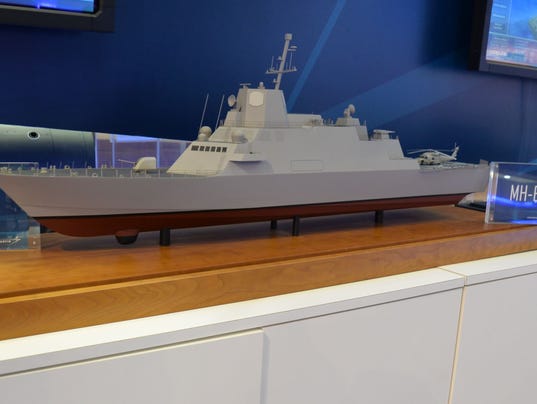BLACKEAGLE
SENIOR MEMBER

A Lockheed Martin model for a surface combat ship on display at the IDEX show in Abu Dhabi displays features offered to the Saudis as part of Saudi Arabia's Eastern Fleet replacement program. The design, developed from Lockheed's littoral combat ship, includes a vertical launch system for surface-to-air missiles and a lightweight SPY-1F Aegis combat system.(Photo: Christopher P. Cavas/staff)
ABU DHABI — The long-sought-after deal to upgrade and replace Saudi Arabia's Eastern Fleet has taken a major step forward, sources said, with the January delivery of a letter of request (LoR) to the US detailing Saudi wishes.
Rear Adm. Jim Shannon, head of the US Navy International Program Office, reportedly obtained the LoR during a visit to Saudi Arabia. The letter marks a major step forward after years of talks and negotiations with the Saudis, who have also strongly considered French proposals to replace their fleet.
The French hold the preponderance of contracts in support of the Saudi's western, or Red Sea, fleet. France and the US are considered the primary contenders for the Eastern Fleet contract, said to be worth as much as $16 billion or higher.
Several sources said the Saudi LoR did not list specific ship designs, but rather gave general guidelines. Among the highlights are:
• Four 3,500-ton frigate-like warships, armed with vertical launch systems (VLS), capable of anti-air warfare and speeds of 35 knots
• 12 1,150-ton corvette-like warships
• 24 or so smaller patrol craft
The deal would include MH-60R helicopters to operate from the frigates, along with support and training.
One condition is the shipbuilder would be the prime contractor.
The US Navy is reportedly working to define details of the LoR, including what air radar the Saudis want to fulfill the anti-air requirement. Sources said that while no specific radar is listed in the LoR, the only system that fits the requirement is the SPY-1F lightweight Aegis system from Lockheed Martin.
SPY-1F is fitted only to Norway's Fridtjof Nansen-class frigates. All other Aegis warships — US cruisers and destroyers, foreign ships including those from Spain, Korea, Japan and Australia — carry the heavier SPY-1D antenna. While there is a high degree of commonality between the two versions, the 1F features smaller antennas and less power, resulting in shorter range.
Lockheed Martin and Austal USA have offered versions of their littoral combat ships fitted with VLS and phased-array radars, including the SPY-1F, both for export and most recently for the US Navy's Small Surface Combatant (SSC) competition conducted in 2014. In the end, the US Navy chose to forego Aegis and VLS on its SSCs, now designated as frigates.
Other than the LCS/SSC/frigate designs, there are no other US projects that would fit the 3,500-ton parameters of the Saudi frigate.
Lockheed Martin in particular has doggedly been holding talks with the Saudis for years about adapting its LCS design to Saudi needs, probably a 118-meter version with a hull similar to the LCS 1 Freedom-class now under construction.
The LoR was transmitted to the US shortly before the Jan. 23 death of the Saudi monarch, King Abdullah. His successor, King Salman, however, was the defense minister at the time of the LoR's transmission, and sources here said the new regime continues to favor the Eastern Fleet plan.
It is not clear from the LoR where the ships are expected to be built, although the frigates would likely be built in the US.
The only other significant US design built in recent years for a foreign customer is the 500-ton Ambassador Mark III class of missile corvettes recently completed for Eqypt. Those four ships, intended to defend the Suez Canal, were built by VT Halter Marine in Pascagoula, Mississippi, but their details don't seem to fit the Saudi LoR.
Saudis Detail Eastern Fleet for US
